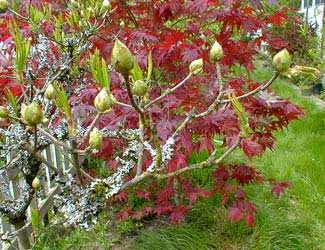
"The Western Flame":
Frank Mossman's & Britt Smith's
Western & Flame Azalea Hybrid
"She 's somewhere in the sunlight strong,
Her tears are in the falling rain,
She calls me in the wind's soft song,
And with the flowers she comes again."
-Richard Le Gallienne
(1866-1947)
(1866-1947)
In the 1960s, Britt Smith & Frank Mossman began collecting coastal azaleas, taking seeds & cuttings from unique Western Azalea specimens spotted from Oregon to Northern California to plant on their properties respectively near the towns of Kent & Vancouver, Washington. The snapshot below shows Smith on the right, Mossman on the left; good lookin' old gents, dontcha agree.
 Our very specimen lived for decades on the Smith property. In 1997 the property was sold as part of a wetland restoration project, which could well have put an end to the marvelous native azalea jungle Britt Smith had created.
Our very specimen lived for decades on the Smith property. In 1997 the property was sold as part of a wetland restoration project, which could well have put an end to the marvelous native azalea jungle Britt Smith had created.The collection was not lost, however. Some 200 shrubs were transplanted in the Lake Wilderness Arboretum (formerly called the South King County Arboretum of Maple Valley). Thus posterity will always be able to visit the Smith-Mossman Azalea Display Garden.
But there were far more shrubs to be moved than could fit even in what was to become the world's largest collection of R. occidentale. The remainder were saved from being plowed under by continuing the "azalea mining" right up until the moment the restoration-developer's plows arrived.
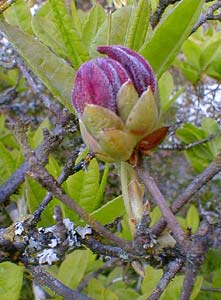 We were fortunate through the Rhododendron Species Foundation to meet the guys who moved the shrubs. There were many more shrubs than could be used at the Arboretum & the "extras" have gone into landscaping here & there, many finding their way into the gardens of members of all the local chapters of the American Rhododendron Society & the Rhododendron Species Foundation.
We were fortunate through the Rhododendron Species Foundation to meet the guys who moved the shrubs. There were many more shrubs than could be used at the Arboretum & the "extras" have gone into landscaping here & there, many finding their way into the gardens of members of all the local chapters of the American Rhododendron Society & the Rhododendron Species Foundation.We felt so lucky to obtain one of these old shrubs. The Britt Smith shrubs had been selected by him over the decades, with an eye for variant traits that he could hybridize. So we thought ours would turn out perhaps to be one of Britt Smith's interespecies hybrids R. oxidentale x oxidentale.
Were we ever in for a surprise!
We'd bought it during its late winter appearance without leaves, which is actually a good time to select well-aged deciduous azaleas, because if they look this gorgeous as limbs & twigs, how can they help but be more wonderful still when they bloom & leaf out. The vendor had had no tag for it & his memory was uncertain which color it was going to be, but white or pink were the choices.
We gave it a premium location of central interest in our garden, & were watching the buds daily swelling, wondering why they were getting so darkly pubescent since we'd been waiting to find out if it was going to be a white one or a pink one.
When it burst into flower it seemed it had to be not the Western Azalea at all, but a Flame Azalea (R. calendulaceum) or possibly the Cumberland Azalea (R. cumberlandense), both of which had been used in the Smith-Mossman hybridization programs.
This was mildly disappointing since we'd already grown emotional over the idea of our garden having a connection to the Smith-Mossman collection of pure & redolent Western Azaleas. Yet Flame Azaleas don't have fat round pubescent purple buds; they have pointy red-orange buds that really do look like flames. I was sorely puzzled!
So I emailed the Arboretum to find out if Britt Smith also had bright orange azaleas, & if so, if they could provide a species or cultivar identification. I heard back from Bob Dunning, & separately from Bill Sloan of B & J Nursery, with assurances that it was indeed R. occidentale. Bob gave me the full specifics of its origin:
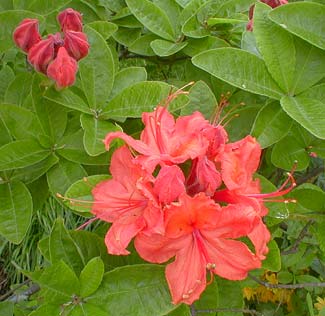 "The plant definitely came from the garden of Britt Smith. I recall someone saying it was an R. occidentale & having some reservations myself about its identity. Britt was not only a plant explorer when he was building his garden, he was also a hybridizer. In particular he made crosses between R. occidentale & R. calendulaceum 'Colossus', an east coast deciduous azalea with vivid orange/red colors & a large flower. There were a number of rows of this cross in Britt's garden. You have one of these plants. The vivid colors of R. calendulaceum always dominated this cross."
"The plant definitely came from the garden of Britt Smith. I recall someone saying it was an R. occidentale & having some reservations myself about its identity. Britt was not only a plant explorer when he was building his garden, he was also a hybridizer. In particular he made crosses between R. occidentale & R. calendulaceum 'Colossus', an east coast deciduous azalea with vivid orange/red colors & a large flower. There were a number of rows of this cross in Britt's garden. You have one of these plants. The vivid colors of R. calendulaceum always dominated this cross."For R. occidentale the sweetly redolent flowers are usually white or pink, but rosier reds & flowers with yellow markings also occur naturally. By extreme contrast, R. calendulaceum, including its larger-flowering species clone 'Colossus' found & preserved by David Leach, is a native of the Appalachean Mountains, & is the orangist of all azaleas. It is the source of the finest oranges in the best Exbury & Knap Hill hybrids.
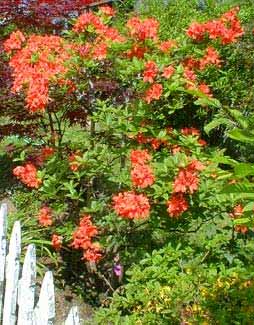 'Colossus' was the pollinator for Frank Mossman's R. occidentale clone 'Stagecoach Frills,' which had enhanced frilliness that passed easily to its progeny. The resultant Western Flames had the large frilliness of 'Stagecoach Frills,' the bright orange of 'Colossus,' preserving also the moisture-tolerant & rot-resistant hardiness of its seed parent. This plant was never given over to production & was never named, so Western Flame will have to do.
'Colossus' was the pollinator for Frank Mossman's R. occidentale clone 'Stagecoach Frills,' which had enhanced frilliness that passed easily to its progeny. The resultant Western Flames had the large frilliness of 'Stagecoach Frills,' the bright orange of 'Colossus,' preserving also the moisture-tolerant & rot-resistant hardiness of its seed parent. This plant was never given over to production & was never named, so Western Flame will have to do.R. occidentale would ordinarily bloom in May, but this hybrid with R. calendulaceum blooms two or three weeks later than the species. Buds take a very long time swelling from small things in winter to enormous buds in May. By the last couple days of May the shrub bursts into bright flower, its primary showiness in June.
While big May buds are swelling to ready-to-burst, the limbs of the shrub simultaneously go from leafless to two-thirds filled out. When it is in full bloom the leaves are still getting thicker & thicker.
In the garden the Western Azalea needs rather thorough watering on a regular basis, as they are unusually sensitive to drought, & could almost be regarded pond shrubs. Flame Azaleas are more moderate in their water usage, but it is easy to tell this one has a Western Azalea's thirst. In the wild they select seepage areas, creek edges, bogs, & places with seasonal flooding, flourishing in the sort of wet peaty conditions that'd cause the average rhododendron to get root-rot & die. Gardened specimens don't need to be flooded of course, but it's best if they never fully dry out.
They have been known to tolerate alkaline soils but loamy neutral to acidic soils are bound to be best. They're not fussy about light exposure either, doing well in full afternoon sun just so long as they never dry out, but the flowers last longer on a shrub that is in dappled sunlight or partial shade.
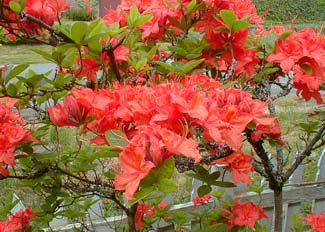 One diminishing factor in the hybrid is that the perfume is not rich as it is for a "pure blood" Western Azalea. In much of the Western Azalea's range in Oregon there are people who call it a Honeysuckle shrub, due only to the marvelous odor, since it has no relationship to Lonicera honeysuckles. The spicy redolence reaches woodland paths long before the flowers are in view. The shrub we have does possess the odor of R. occidentale, but disappointingly subdued. You have to stand close to the shrub to smell the blossoms at all.
One diminishing factor in the hybrid is that the perfume is not rich as it is for a "pure blood" Western Azalea. In much of the Western Azalea's range in Oregon there are people who call it a Honeysuckle shrub, due only to the marvelous odor, since it has no relationship to Lonicera honeysuckles. The spicy redolence reaches woodland paths long before the flowers are in view. The shrub we have does possess the odor of R. occidentale, but disappointingly subdued. You have to stand close to the shrub to smell the blossoms at all.In the wild Western Azaleas reach fifteen feet, but in gardens four to eight feet would be large. Flame Azaleas can reach twenty feet, but likewise remain smaller in gardens. Our Britt Smith shrub is six feet tall, having a loose & airy limb structure typical of Western Azaleas. It looks wonderful even in winter undress, as the silhouette of its lichen-encrusted branches evokes a rugged beauty.
The first photo up top shows a lichen-encrusted limb with terminal flower-buds still green at the very start of May, having only a few of the leaf-buds beginning to reveal leaves. In the background is an 'Oshio Beni' Japanese Maple.
The second photo is a close-up of a single bud at mid-May, looking very purple & pubescent. These buds continue to swell & slowly turn from purply-pink to a dusty orange that is as colorful as certain Exbury or Knaphill hybrid azaleas. These many burgeoning buds open into large rich dark orange trusses of trumpets by the last couple days of May. The third photo shows leaves, bud, & full opened blossom at May's end.
The shrub is most densely flowered in June. The fourth photo shows whole shrub at the start of June, & the final photo shows June blossoms close in. This shrub had no shortage of bees tending to it.
This unique specimen also has wonderful autumn foliage
as can be seen on the:
'Western Flame' Page of the Autumn Azaleas Garden Walk.
& for additional bloom photos, see the
'Western Flame' Page of the Rhododendron & Azalea Blooms Gallery
& for the wild western azalea, see the
Rhododendron occidentale page
as can be seen on the:
'Western Flame' Page of the Autumn Azaleas Garden Walk.
& for additional bloom photos, see the
'Western Flame' Page of the Rhododendron & Azalea Blooms Gallery
& for the wild western azalea, see the
Rhododendron occidentale page